BCM206: Wanderlust – The Travel Companion
- crosewales15
- Oct 23
- 7 min read
Final Contextual Report: Charli Wales
Introduction
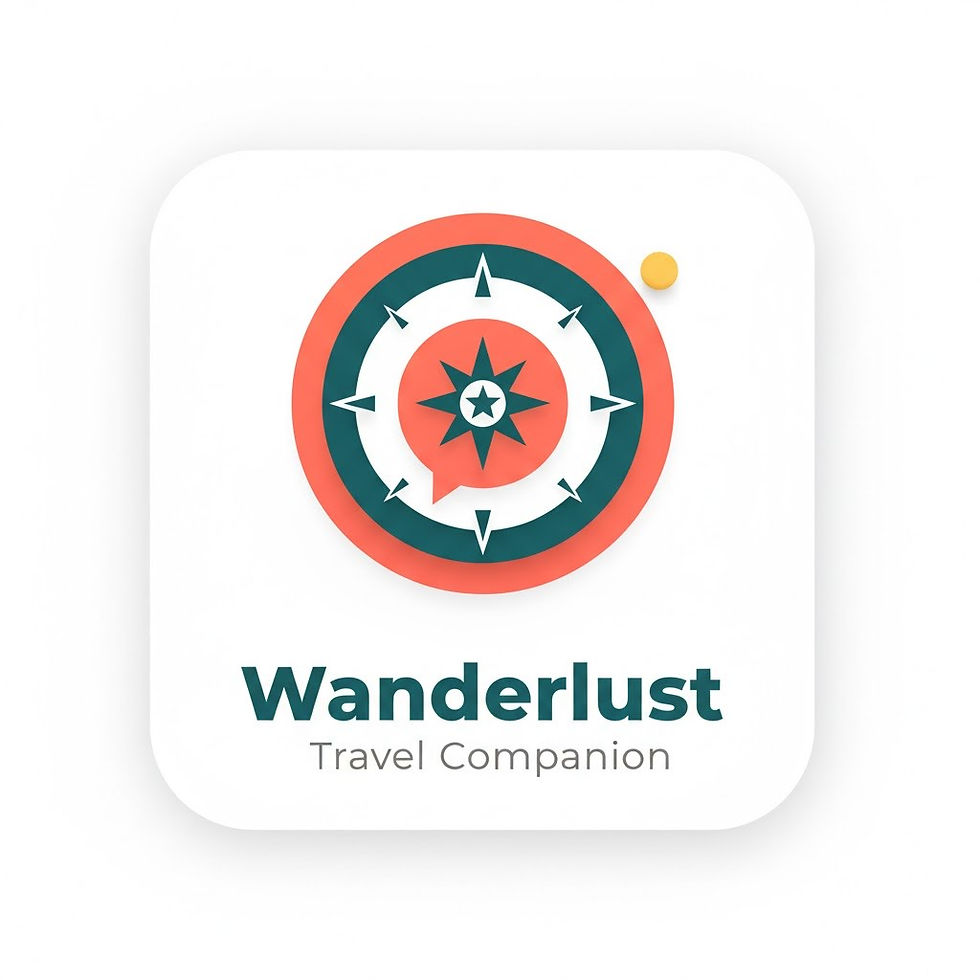
Wanderlust: The Travel Companion is a digital artefact designed to support solo travellers and backpackers through connection, guidance, and inspiration. Initially conceptualised as a travel planning app with curated itineraries and local recommendations, the project has evolved into a community-driven platform that aims to make solo travel more accessible, connected, and enjoyable. Over the course of this semester, my focus has been on developing new ideas for the app’s functionality, experimenting with AI integration, and refining the marketing approach through social media.

This contextual report documents five weeks of iterative development, showing how feedback, user insights, and ongoing analysis have informed the evolution of Wanderlust. By adopting an adaptive project development approach and critically engaging with concepts such as participatory culture and iterative design, I have continued to refine the project to better meet user needs and strengthen its social utility.
Week 1 – Refinement and Research
(click the full screen to see graphs clearly)
At the start of this development cycle, my goal was to reassess Wanderlust through the lens of openness and social utility. I began by creating a survey targeting young travellers and backpackers to better understand their challenges, habits, and expectations from a travel companion app. The questions explored topics such as solo travel fears, trust in online recommendations, and preferred app features.
Early responses revealed a recurring theme: travellers wanted connection, safety, and quick access to reliable information. This feedback reinforced the importance of Wanderlust’s community features and highlighted a gap in real-time, conversational support for travellers, particularly those navigating unfamiliar countries. These insights formed the foundation for exploring a chatbot assistant as a potential new feature.
Week 2 – Concept Development: AI Chatbot Integration
Building on user feedback, I began developing a concept for an AI-powered chatbot, designed to function as a digital travel assistant within the app. The proposed feature, nicknamed “Wanda,” would act as a friendly, real-time guide, answering travel questions, suggesting destinations, translating phrases, and recommending safety tips.
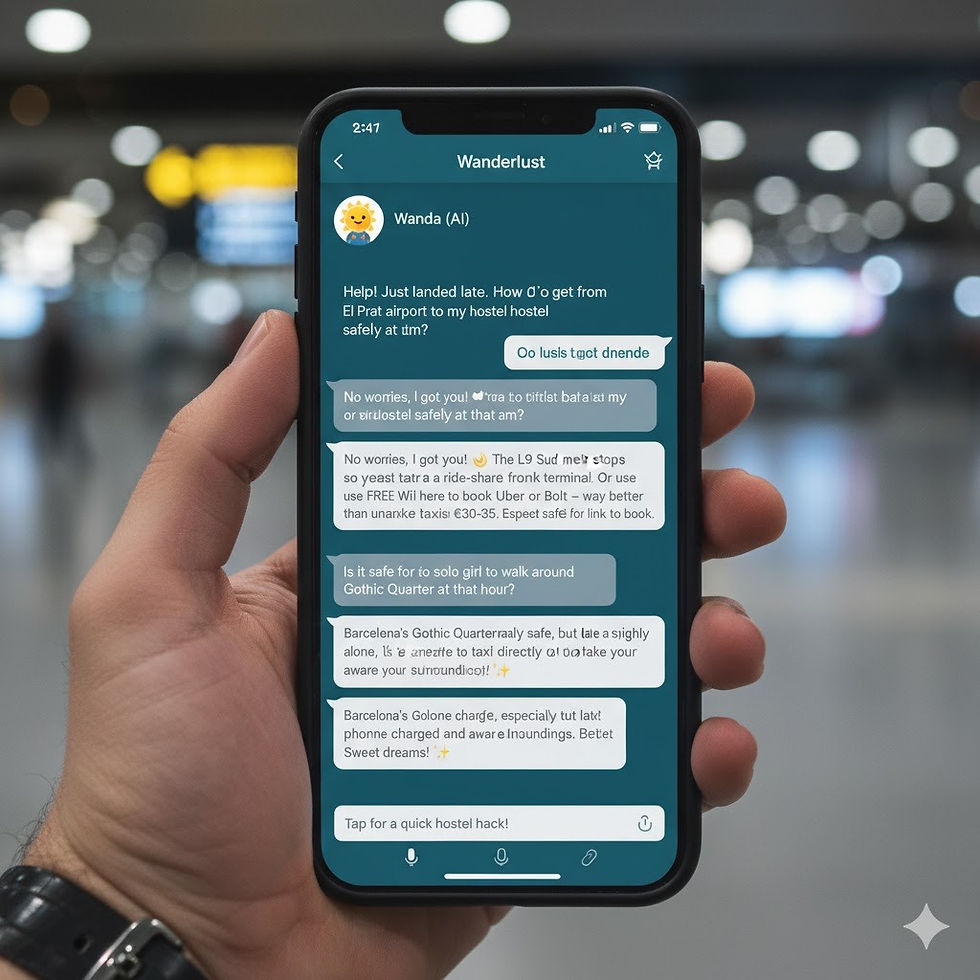
During this week, I created a chatbot flowchart mapping different user interactions. For example, if a user typed “Where can I meet other travellers in Bali?”, Wanda could suggest nearby hostels or local meetups. This conversational interface would offer personalised support, bridging the gap between digital information and human connection.
The introduction of AI also prompted ethical considerations around privacy and data use. I researched chatbots used in travel platforms like Hopper and Expedia to ensure responsible design principles. By analysing these case studies, I recognised the importance of maintaining transparency, especially for a young audience that values authenticity and trust.
This stage marked a turning point in the app’s conceptual depth, transforming Wanderlust from a static planning tool into an interactive travel companion capable of adapting to user needs in real time.
Week 3 – Strengthening Community and Connection
In Week 3, I focused on expanding Wanderlust’s social features to enhance its community-driven nature. Drawing on Jenkins’ (2006) idea of participatory culture, I explored how travellers could contribute content, share experiences, and co-create value within the app.
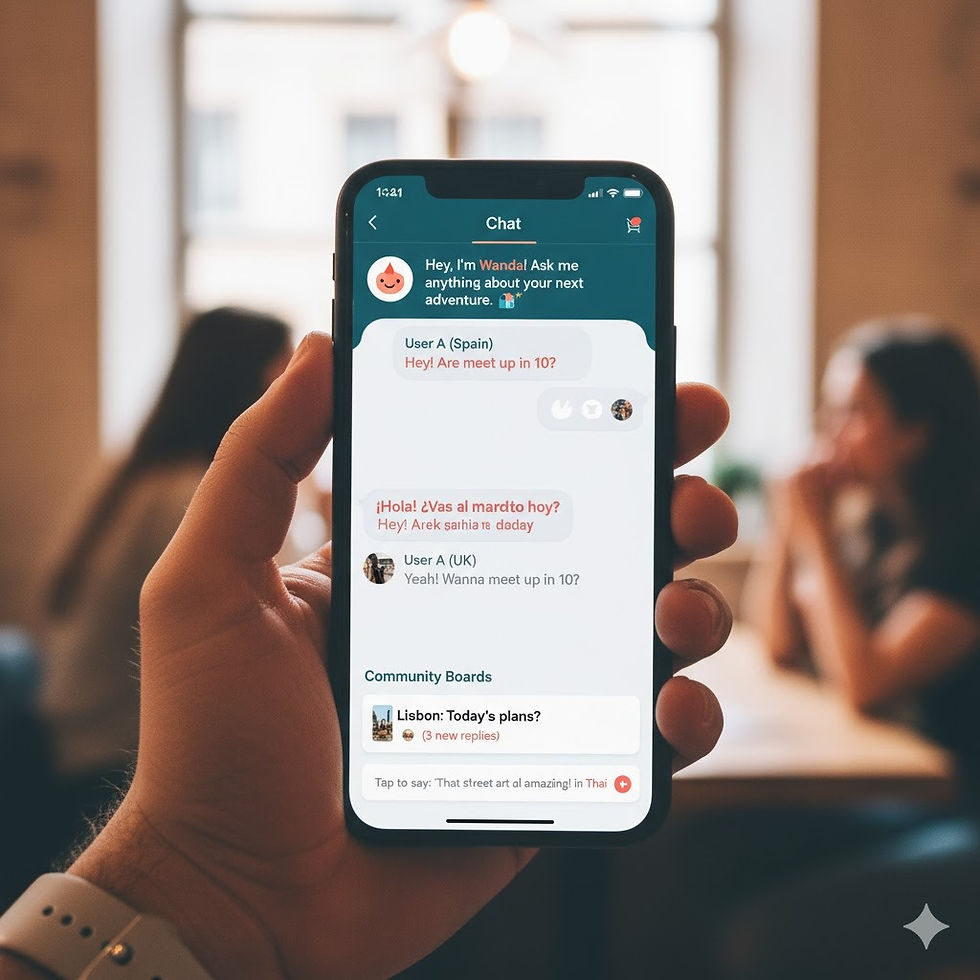
I developed the concept for a “Travel Buddy Finder” feature, allowing users to connect with others heading to similar destinations or attending the same events. This would encourage peer-to-peer support, reduce the loneliness often felt during solo travel, and create opportunities for collaboration.
Additionally, I designed a new “Local Insights” page, where travellers could post short reviews, hidden gems, or safety tips. Unlike traditional travel guides, this feature emphasises authenticity and diversity of experiences, aligning with the peer-generated nature of modern travel media.
To visualise these ideas, I created mockups of the updated app interface, highlighting how the chat and profile sections could work together to encourage connection. This week demonstrated how Wanderlust could evolve beyond its original concept by integrating the social dynamics of digital communities into its core functionality.
Week 4 – Marketing and Brand Strategy
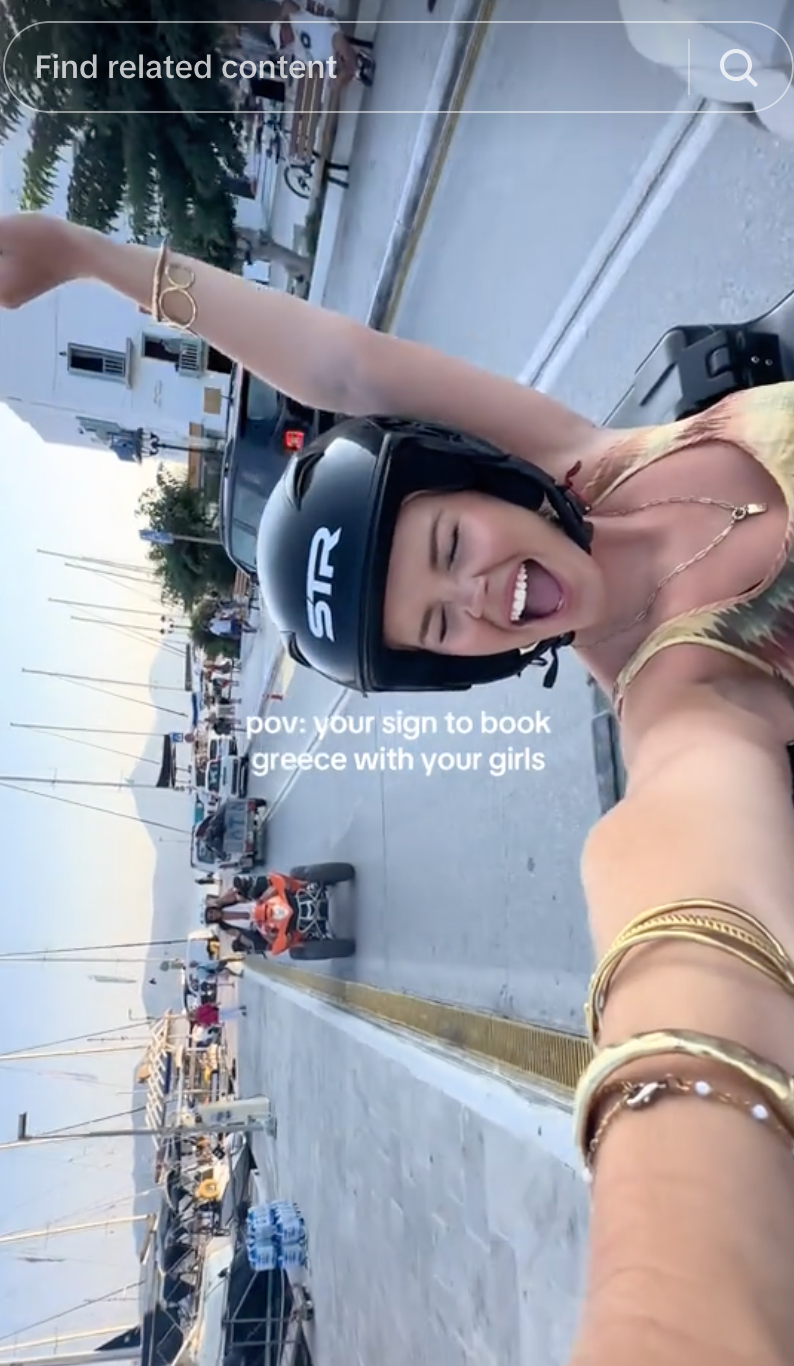
During this stage, my focus was on strengthening the marketing and content strategy for Wanderlust: The Travel Companion. I created and shared several short-form TikTok videos that showcased travel aesthetics ensuring the videos were under 15 seconds as this is known to be the most engaging video, also utilising trends such as “POV: your sign to book Greece with your girls” and cinematic clips of scenic destinations.
While these posts aligned with the visual identity of Wanderlust, they primarily centred around aesthetic appeal rather than interaction or storytelling.
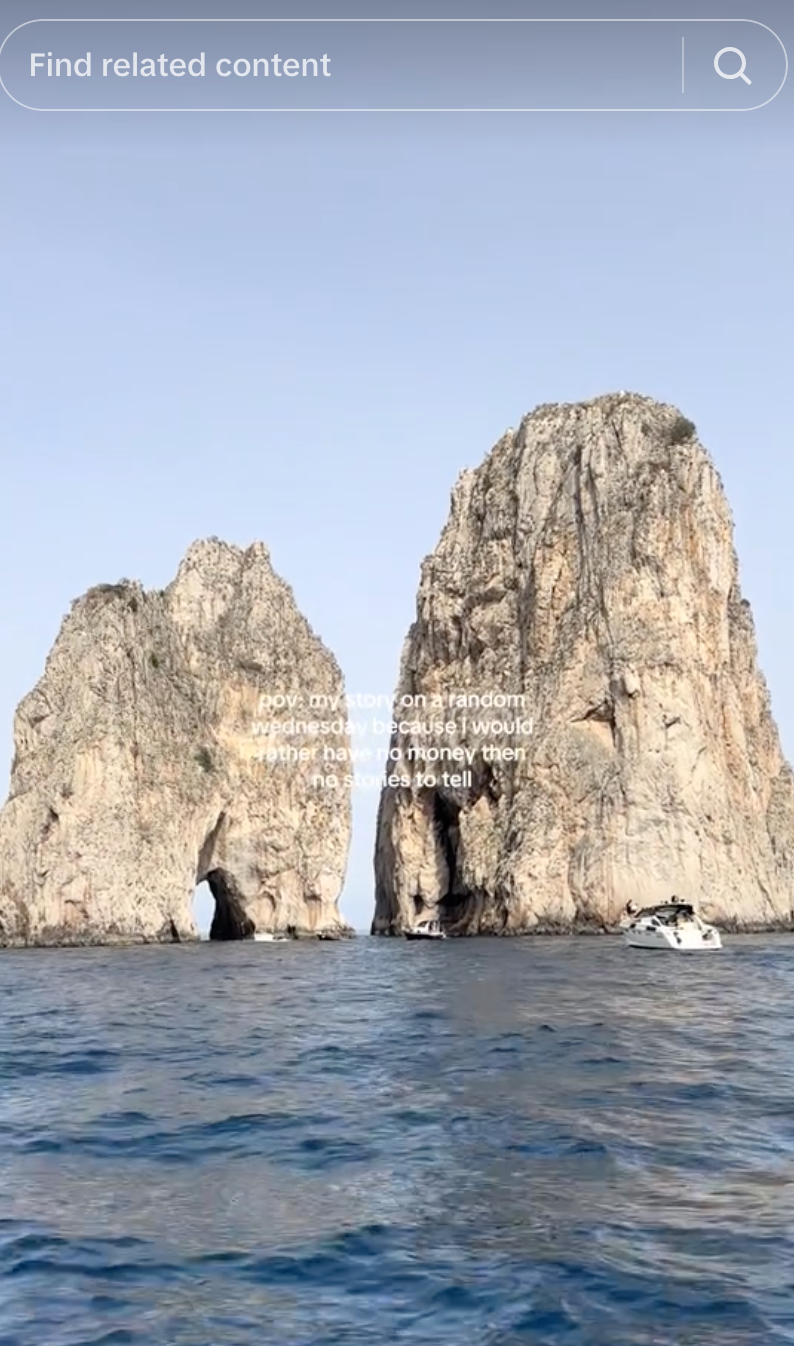
After analysing the engagement data, I noticed that these videos didn’t perform as well as expected in terms of comments, saves, and follower growth. This suggested that while the visuals were appealing, they didn’t fully capture or sustain audience interest. Reflecting on this, I realised that future content should focus more on utility and connection rather than aesthetics alone.
However, part of the challenge during this phase was that the app is not yet fully functional. Without a live, usable version of Wanderlust, it was difficult to demonstrate its features or showcase real user experiences. Once the app is operational, I plan to integrate behind-the-scenes videos, demonstrations of in-app features, and authentic testimonials from travellers using Wanderlust in real time. This will give the project greater depth on social media and allow potential users to see its real-world value.
I initially started with my old Wanderlust account (shown in Image 1), which gained a small following early on. However, most of that engagement came from friends showing support rather than a genuine audience interested in the concept. Wanting to test how the project would perform beyond my inner circle, I decided to start fresh and rebuild the page from the ground up. I also revived one of my old travel accounts to post new content and experiment with what resonates most with real travellers. While growth has been slower than expected, I’ve stayed consistent, still uploading regularly and planning to keep building momentum as the app develops.
Going forward, I plan to experiment with more interactive content formats, for example, short travel tips, user testimonials, and behind-the-scenes videos showing app features in action. Including more direct calls-to-action, question prompts, and educational elements will likely make the posts more relatable and shareable for my target audience of backpackers and young travellers.
Week 5 – Testing, Feedback, and Reflection
The final week of development focused on gathering and analysing peer and user feedback on the updated app concept. I presented my prototypes and chatbot ideas to classmates within the BCM206 network, receiving valuable suggestions on tone,, accessibility, and visual design.

One recurring insight was the importance of keeping Wanda, the AI chatbot, approachable and conversational, users wanted helpfulness without formality. Another recommendation was to add group chat options for travellers heading to the same cities, which could help form instant communities.
I incorporated this feedback into a future development roadmap, outlining the next six months of potential updates:
Finalise AI chatbot and integrate safety verification features.
Introduce group chat and event-based meetups.
Build an offline mode for low-connectivity areas.
Continue expanding TikTok engagement through community-generated content.
This iterative reflection reinforced the importance of adaptive project development. By continually testing, analysing, and refining the concept based on real input, Wanderlust remains grounded in user experience rather than abstract design ideas.
Learning Moments and Theoretical Reflection
A major learning moment throughout this project was understanding the value of iterative design and participatory culture in digital media creation. Gabora and Ganesh (2020) highlight that iterative design encourages creators to cycle between feedback, reflection, and revision, exactly the process that shaped Wanderlust’s evolution this semester.
Equally, Jenkins’ (2006) framework of participatory culture informed my approach to user-generated content and community design. Rather than building an app for travellers, Wanderlust aims to be built with them, empowering users to share advice, stories, and insights that enhance the collective travel experience.
Engaging in peer networks and within the BCM206 community also demonstrated the importance of collaborative learning. Through weekly check-ins, I received constructive input on the chatbot’s functionality, interface colour palette, and potential ethical considerations from my friends and peers. These interactions not only refined my design thinking but also reflected the open, networked nature of digital media practice.
Another key learning area was recognising the difference between polished aesthetics and authentic utility. While earlier versions of Wanderlust prioritised clean visuals, this iteration focused on openness, accessibility, and relatability, qualities that make digital artefacts more socially valuable and user-centric.
Demonstration of Openness and Utility
At this stage, Wanderlust: The Travel Companion is not yet a fully functional or publicly accessible application. The app remains in its prototype phase, with development focused on refining the interface, chatbot concept, and overall user journey before public launch. Because of this, its current utility lies in its conceptual and design potential rather than active user interaction.

Although the app itself is not available for public download or use, the project maintains a degree of openness through its documented progress on social media platforms such as TikTok and Instagram. These accounts have been used to share updates, design previews, and promotional teasers to introduce the Wanderlust concept to a travel-focused audience.
This public documentation encourages community feedback and creates early awareness among potential users, even before the app becomes accessible.
Once functional, Wanderlust will be released as a mobile application designed to support solo travellers and backpackers. Its purpose is to provide social and practical utility by helping users connect with others, discover local recommendations, and plan itineraries. Future updates will include a chatbot assistant to personalise travel support and offer real-time advice based on user preferences and destinations.
While the project is still in development, this phase has allowed for foundational research, concept validation, and early-stage engagement with the target audience. The openness of the design process, sharing prototypes, surveys, and marketing experiments, demonstrates a transparent and iterative approach to development. This ensures that once Wanderlust becomes a functional and publicly accessible app, it will be grounded in real user insight and provide genuine value to the travel community.
Conclusion
The past five weeks of Wanderlust’s development have reflected the true essence of digital media practice, constant adaptation, experimentation, and collaboration. By integrating user feedback, peer insights, and theoretical reflection, I have transformed the project from a planning-based app into an evolving, community-oriented travel companion.
Each phase, from the initial survey and chatbot ideation to TikTok marketing and peer feedback, has contributed to a richer, more socially grounded artefact. The process has reinforced that meaningful digital artefacts must remain open, useful, and responsive to the communities they serve.
As Wanderlust continues to grow, its goal remains simple yet powerful: to connect travellers, empower exploration, and make every journey, no matter how solo, feel supported.
References
Bhandari, N. (2022). Optimising social media strategy: Insights for brands on TikTok engagement. Journal of Digital Media Studies, 11(3), 45–58.
Gabora, L., & Ganesh, S. (2020). Iterative design and its impact on digital innovation. Design Studies Journal, 41(1), 78–92.
Jenkins, H. (2006). Convergence Culture: Where Old and New Media Collide. New York University Press.
Assisted by ChatGPT



















Comments